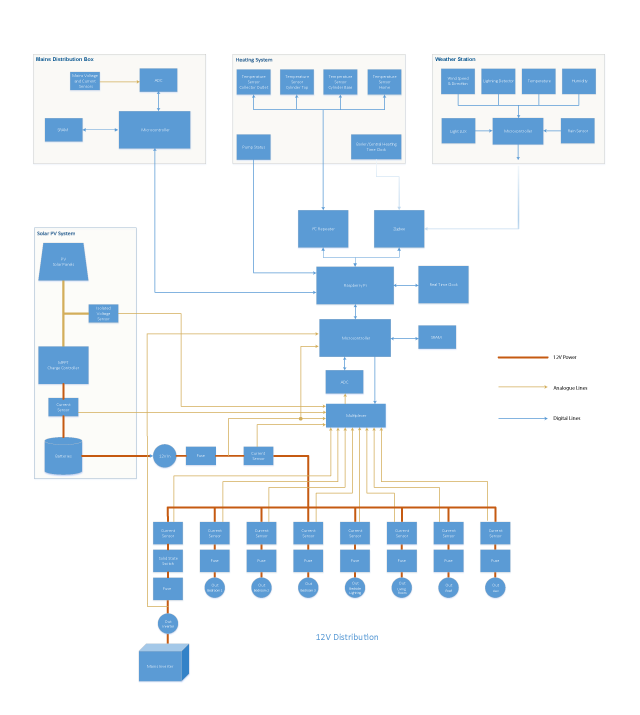It has now been a year since the first Raspberry Pi solar data logger was launched and over the past 12 months, it has been running continuously uploading data from our sensors to our online reporting site at home.briandorey.com every minute.
We are now planning to build a new energy logging system using the Raspberry Pi to process and upload the data and also store a local copy on a MySQL database to enable an Android tablet in the house to easily view the data and also update the central heating system timer settings.
The current system comprises of the following sensors:
- AC Current on mains consumer input.
- DC Current on solar PV input
- DC Current on mains inverter input
- DC Current on the battery to distribution fuse box
- Voltage sensor on 12V battery bank
- Solar Thermal pump running sensor
- Temperature sensor on water cylinder top
- Temperature sensor on the water cylinder base
- Temperature sensor on the thermal solar panel output pipe
- Temperature sensor in the house
We are now planning to include the following additional sensors and upgrades
Full central heating control via the Central Heating Control via Windows Phone and Raspberry Pi project and new interface and back end to use the Raspberry Pi to control the central heating boiler times and settings.
Gas boiler running sensor using a flame detector
Gas meter logging using a reed switch on the meter and new logging/counter board which will interface with the Raspberry Pi
Additional mains current sensors on each fuse so we can log the current consumption on each circuit.
Voltage monitoring for solar PV panel input in addition to the current sensor being used on the current version.
Combined controller PCB and 12V distribution board with current sensors for each low voltage circuit and overload protection on each output. The new board will include a multiplexer connected to a single high-resolution high-speed ADC which can sample multiple inputs via a PIC processor. The use of a separate microcontroller for sampling will free up the Raspberry Pi to perform other tasks without hogging the processor. It will also allow us to sample all of the channels once a second and then average out the values over 1-minute intervals. The average and peak values for the previous minute can then be saved into the local database on the Raspberry Pi and uploaded to the online website.
The PIC processor will also control the low voltage cut-off for the inverter with the switch-on and switch-off levels as well as override commands available from the Raspberry Pi.
A new weather station is also planned once the new solar logger is complete. The weather station will include an ultrasonic wind speed and direction sensor, temperature, humidity, UV and visible light levels and a lightning detector. This will allow us to gain a much better oversight of the efficiency of our PV and hot water panels in different weather conditions.
At the moment we are still in the planning stage for each part of the system but the flow chart below shows how each part of the system will be interconnected.
Click to view the PDF version.

Comments